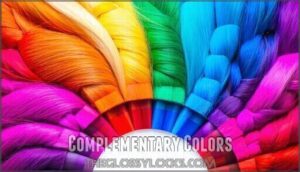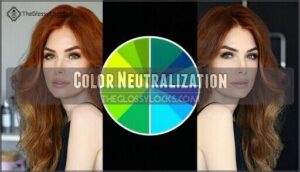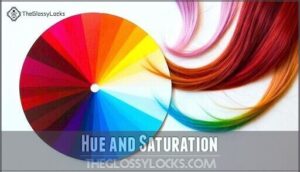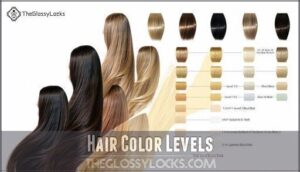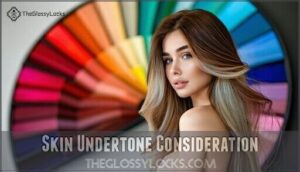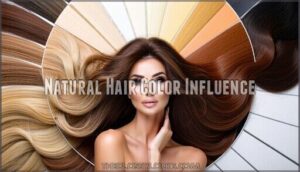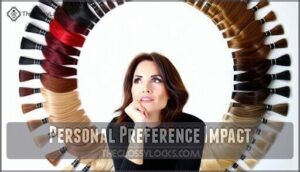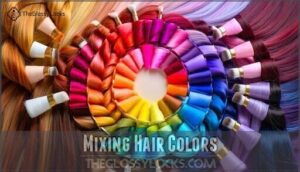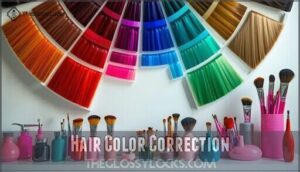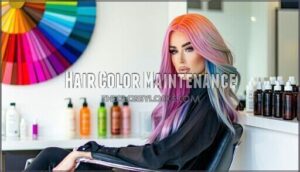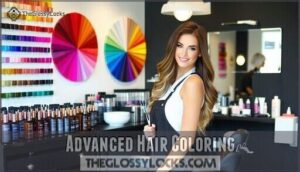This site is supported by our readers. We may earn a commission, at no cost to you, if you purchase through links.
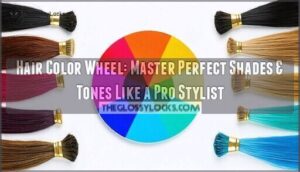 A hair color wheel is your roadmap to perfect color choices.
A hair color wheel is your roadmap to perfect color choices.
It shows how primary colors (red, blue, yellow) mix to create secondary and tertiary shades.
You’ll use it to identify complementary colors that neutralize unwanted tones – like purple canceling yellow brassiness.
The wheel helps you understand warm versus cool undertones, so you can match colors to your skin tone.
Think of it as your color GPS – it prevents you from getting lost in bad hair decisions.
Professional stylists rely on this tool to create custom formulations and fix color mishaps.
Master this basic tool, and you’ll discover the secrets behind every stunning hair transformation.
Table Of Contents
- Key Takeaways
- Hair Color Basics
- Color Wheel Dynamics
- Hair Color Levels
- Choosing Hair Color
- Mixing Hair Colors
- Hair Color Correction
- Hair Color Maintenance
- Advanced Hair Coloring
- Frequently Asked Questions (FAQs)
- What is the hair colors wheel?
- What is a color wheel chart in hairdressing?
- How do I use the hair color wheel?
- Can a hairdresser use a color wheel?
- How does a hair color wheel work?
- What is a hair color wheel spinner?
- What color hair makes you look younger?
- Should you go darker or lighter with hair color as you age?
- What is a hair color wheel?
- What is a color wheel & how does it work?
- Conclusion
Key Takeaways
- You’ll use complementary colors from the hair color wheel to neutralize unwanted tones—purple cancels yellow brassiness, blue eliminates orange, and green neutralizes red for perfect color correction results.
- You need to identify your hair’s natural level (1-10 scale) and match it with your skin’s undertones (warm, cool, or neutral) to choose colors that’ll flatter your complexion and work with your base shade.
- You can create custom hair color formulations by mixing primary colors (red, blue, yellow) to achieve secondary and tertiary shades, while understanding how developer strength affects your final color outcome.
- You’ll maintain vibrant hair color longer by using sulfate-free shampoos, washing with cool water, applying UV protection, and scheduling regular touch-ups to prevent fading and keep your color looking salon-fresh.
Hair Color Basics
Understanding the hair color wheel starts with mastering three primary colors: red, blue, and yellow.
You’ll use these foundational colors to create secondary and tertiary shades while learning how warm and cool tones affect your final results.
Primary Colors
Everything begins with primary colors—the building blocks that make your hair color wheel work like magic.
Red shades, blue hues, and yellow tones form the foundation of color theory, creating every stunning transformation you’ve ever admired.
These pigment basics release your creative potential through pure, unmixed colors that can’t be created by combining others.
Master these fundamentals and you’ll understand how color neutralization transforms ordinary hair into extraordinary art.
- Red ignites passion and creates warmth that draws attention
- Blue brings coolness that balances unwanted brassiness
- Yellow radiates sunshine and brightens your overall look
- Together they create harmony that makes heads turn
Secondary Colors
Building on primary colors, secondary colors reveal your hair’s true potential.
When you mix red and yellow, you get orange tones. Blue and red create purple hues. Yellow and blue produce green shades.
These secondary blends form the backbone of color wheel theory. Understanding color mixing helps you predict results and avoid muddy outcomes when creating custom formulations.
Tertiary Colors
Secondary colors give you options, but tertiary colors reveal true artistry.
You’ll create these sophisticated shades by mixing primary colors with secondary ones. Think red-orange for vibrant copper or blue-green for stunning teal effects.
This color blending expands your hair color wheel possibilities dramatically. Master tonal analysis and hue variation to achieve perfect shade creation and color harmony every time.
Understanding the different hair dye types is vital for selecting the right color and achieving the desired effect.
Warm and Cool Tones
Temperature transforms your hair color wheel from basic to brilliant. Understanding warm and cool tones reveals professional-level results every time.
Color temperature
- Warm tones deliver golden copper and rich auburn undertones
- Cool undertones showcase ashy platinum and blue-based hues
- Neutral hues balance between temperature extremes perfectly
Color Wheel Dynamics
You’ll master color relationships by understanding how opposite colors neutralize unwanted tones in your hair.
The wheel shows you which complementary colors cancel each other out, like purple toners removing yellow brassiness from blonde hair.
Complementary Colors
Complementary colors sit directly opposite each other on the hair color wheel. These powerful pairs create stunning hue contrast when placed side by side.
Purple cancels yellow, blue neutralizes orange, and red balances green. You’ll achieve perfect color harmony by understanding these relationships.
When mixed together, complementary colors produce beautiful neutral shades instead of muddy results.
| Color Pair | Primary Use | Result |
|---|---|---|
| Purple + Yellow | Blonde toning | Neutral beige |
| Blue + Orange | Brassy correction | Cool brown |
| Red + Green | Color balancing | Soft gray |
| Teal + Coral | Creative mixing | Muted lavender |
| Violet + Gold | Tone matching | Ash blonde |
This color theory foundation facilitates professional-level color balance techniques, which is essential for achieving perfect color harmony and creating stunning visual effects with complementary colors.
Color Neutralization
Color neutralization transforms hair disasters into victories.
When unwanted tones appear, you’ll use opposing shades from the hair color wheel.
Neutralizing pigments cancel brass with blue, while green eliminates red.
This tone correction technique restores color balance through strategic shade adjustment.
Master hue calibration by understanding which colors neutralize each other—it’s your secret weapon for flawless results every time.
Hue and Saturation
Understanding hue shift and saturation levels reveals your creative potential with the hair color wheel.
Hue represents the pure color family—red, blue, or yellow—while saturation controls color intensity.
High saturation creates vibrant, bold results. Low saturation produces muted, natural-looking tones.
Color depth changes when you adjust these elements together. Tone variation happens through color theory principles.
Master this balance, and you’ll achieve perfect color neutralization while controlling exactly how vivid or subtle your final shade appears.
Hair Color Levels
Understanding your hair’s natural level is the foundation of successful color work, whether you’re going lighter or darker.
Hair levels range from 1 (black) to 10 (lightest blonde), and knowing your starting point determines what colors you can achieve and which techniques you’ll need to get there, based on your natural level and desired outcome to achieve successful color work.
Level Identification
Your hair’s natural darkness acts like a roadmap for successful coloring. Hair levels range from 1 (jet black) to 10 (lightest blonde), creating the foundation for all Color Levels decisions.
You’ll need to identify your starting point before choosing any shade. The hair color wheel works best when you understand your current level versus your desired outcome.
- Level 1-3: Deep brunettes requiring significant lifting for lighter shades
- Level 4-6: Medium browns offering versatile Shade Matching options
- Level 7-8: Light browns perfect for subtle Tone Analysis adjustments
- Level 9-10: Blonde bases ideal for Level Conversion experiments
Impact on Color Outcome
Your hair’s starting level determines everything that follows.
Pigment distribution varies dramatically between level 2 black hair and level 8 blonde—affecting how dye absorption occurs.
Dark hair requires pre-lightening for vibrant results, while lighter levels accept color more readily.
Shade variation depends on this foundation, with color theory guiding your choices.
Poor tone correction happens when you ignore level compatibility.
The hair color wheel shows which color techniques work best, ensuring successful hair color mixing and proper color neutralization for your desired outcome.
Level and Tone Relationship
Now that you understand how levels impact your color intensity, let’s explore how levels and tones work together.
Think of color level as your foundation and hair tones as your personality.
A Level 7 blonde with warm undertones creates honey hues, while cool undertones produce ashy results.
The hair color wheel guides this Color Balance—matching your Color Depth with complementary Tone Mapping creates stunning Hair Dimension through strategic Level Shift techniques.
Choosing Hair Color
You’ll need to match your hair color choice to your skin’s undertones and your natural hair level for the best results.
Your personal style preferences matter too, but they work best when they complement your natural coloring rather than fight against it, considering complete concepts and natural coloring.
Skin Undertone Consideration
Your skin’s secret language reveals itself through undertone analysis—the foundation of perfect color matching. Understanding your undertones transforms hair color decisions from guesswork into science.
Here’s how to decode your skin tones:
- Check vein colors: blue indicates cool undertones, green suggests warm undertones
- Notice sun reactions: burning easily means cool, tanning easily means warm
- Test jewelry preferences: silver flatters cool undertones, gold complements warm undertones
- Use the white cloth test: yellowish appearance indicates warm, pinkish suggests cool
The hair color wheel becomes your roadmap for tone correction and facial harmony. Cool undertones pair beautifully with ash and platinum shades, while warm undertones glow with golden and copper tones. Neutral undertones? You’ve hit the jackpot—most natural hair colors work perfectly with your balanced skin tone, giving you freedom to experiment with color theory principles. Cool undertones are often associated with ash and platinum shades, and warm undertones with golden and copper tones.
Natural Hair Color Influence
Working with your base shade reveals your hair’s true potential.
Melanin production determines your starting point—whether you’ve got light blonde or deep brunette natural pigments.
Your genetic influence shapes how new colors blend with existing hair pigmentation.
Understanding natural hair options is vital for making informed decisions about your hair color.
| Natural Base | Color Variation | Best Enhancement |
|---|---|---|
| Light Blonde | High absorption | Pastels, vibrant hues |
| Medium Brown | Moderate lift needed | Warm reds, golden tones |
| Dark Brown | Requires pre-lightening | Rich chocolates, auburns |
| Black Hair | Heavy lifting essential | Deep jewel tones |
| Red Hair | Unique undertones | Copper variations, burgundy |
The hair color wheel guides these transformations perfectly.
Personal Preference Impact
Your personal color palette becomes your signature when you embrace the hair color wheel.
Color psychology reveals how shades reflect your hair identity and personal style. Cultural influence and aesthetic taste guide your individual hair color choices, while hair color trends offer inspiration.
Consider these factors when choosing your perfect shade:
- Lifestyle compatibility – busy schedules need low-maintenance colors
- Professional requirements – workplace policies may limit bold choices
- Seasonal preferences – darker tones for winter, brighter for summer
- Confidence boosters – colors that make you feel powerful and authentic
Mixing Hair Colors
You’ll create your perfect shade by mixing different hair colors to match your client’s unique needs and desired outcome.
Combining base colors with the right developer ratio guarantees consistent, professional results that won’t disappoint, ensuring perfect outcomes.
Custom Formulation
Creating your signature shade starts with precise Color Matching using the hair color wheel. Master Custom Blends by adjusting Pigment Ratio for perfect Tone Creation. Formula Adjustment transforms basic colors into personalized masterpieces.
Understanding various hair color products is essential for achieving desired results.
| Base Color | Toner Addition | Dream Result |
|---|---|---|
| Level 7 Brown | Ash Green | Cool Chocolate |
| Level 9 Blonde | Purple | Platinum Ice |
| Level 6 Red | Blue | Rich Mahogany |
Mix tones strategically for color correction that exceeds expectations every time.
Developer Selection
Beyond the hair color wheel lies the secret weapon: developer selection.
Your developer types determine whether you’ll achieve stunning color results or face unwanted surprises. Volume control makes all the difference when targeting specific color levels.
Understanding the right volume levels is vital for superior results.
- 10 Volume: Perfect for toner choice and deposit-only applications
- 20 Volume: Gray coverage and one-level lifter selection
- 30 Volume: Two-level lift with enhanced color depth
- 40 Volume: Maximum lift for dramatic transformations requiring hair color correction
Color Combination Techniques
Once you’ve selected your developer, Color Mixing becomes your artistic playground.
Master Tone Blending by combining adjacent wheel colors for natural shifts. Shade Matching requires understanding Pigment Balance – mix complementary colors in small ratios to neutralize unwanted tones.
Hue Combination works best when you respect color theory principles.
| Technique | Best For | Pro Tip |
|---|---|---|
| Adjacent Mixing | Natural gradients | Use 3:1 ratios |
| Complementary Blend | Color neutralization | Start with tiny amounts |
| Analogous Harmony | Seamless transitions | Stay within 3 colors |
| Triadic Balance | Bold statements | Equal proportions work |
| Split-Complementary | Subtle contrast | Softer than direct opposites |
Hair Color Correction
Hair color correction fixes mistakes and unwanted tones using strategic color theory principles. You’ll master techniques that neutralize brassiness, fill gaps, and transform hair disasters into salon-quality results.
Filling Technique
When darker hair dreams meet bleached reality, you’ll need the Filling Technique to bridge those Filling Gaps. This Hair Filling method rebuilds missing pigments before your final Color Deposit.
Here’s your game plan:
- Use warm undertones from your hair color wheel for depth
- Layer Color Blending gradually to prevent muddy results
- Match your color chart recommendations for balanced Hair Coloring
Master this Filling Technique and watch patchy disasters transform into salon-worthy masterpieces.
Neutralizing Unwanted Tones
When brassy tones crash your color party, the color wheel becomes your rescue tool.
Neutralizing colors work like magic—purple kills yellow, blue destroys orange, green eliminates red through color neutralization.
Toners deliver professional tone correction and shade adjustment.
| Unwanted Tone | Neutralizer |
|---|---|
| Yellow/Brass | Purple/Violet |
| Orange | Blue |
| Red | Green |
Master hue balancing for flawless hair color correction techniques every time.
Color Correction Methods
Color correction transforms hair disasters into stunning results.
When your tone correction goes sideways, these hair color correction techniques will rescue you:
- Apply color fixing formulas using opposite wheel colors
- Use shade adjustment toners for subtle tweaks
- Try pigment removal treatments for stubborn hues
- Master hue balancing with complementary shades
- Perfect neutralizing colors through strategic application
Colorcorrecting becomes simple with practice.
Hair Color Maintenance
You’ve invested time and money in your perfect color, but keeping it vibrant requires consistent care and the right techniques.
Understanding how to prevent fading, maintain hair health, and execute proper touch-ups will extend your color’s lifespan and keep it looking salon-fresh between appointments, which is crucial for maintaining a salon-fresh look.
Color Fading Prevention
Smart color preservation starts with understanding fading causes like heat and harsh products.
Master fade prevention with these shade stabilizers:
- Wash with cool water using sulfate-free shampoo to prevent color deposit loss
- Apply UV protection before sun exposure to maintain color levels
- Use color-locking treatments weekly to combat color buildup breakdown
Your hair color wheel knowledge means nothing without proper maintenance habits.
Regular trims and deep conditioning are part of a color preservation routine that helps maintain vibrant locks.
Hair Health Importance
You can’t build a masterpiece on a crumbling foundation—healthy hair is your canvas for stunning color results.
Hair Care and Scalp Health directly impact how well your strands hold pigment and resist fading.
| Hair Health Factor | Color Impact |
|---|---|
| Hair Porosity | Controls dye absorption |
| Hair Condition | Affects color evenness |
| Split Ends | Creates patchy results |
Breakage Prevention starts with gentle handling and protein treatments.
Deep conditioning fights Hair Damage while nourishing masks restore moisture.
Strong, well-maintained strands showcase the hair color health you’ve worked to achieve.
Color Touch-Up Techniques
Touch-ups become effortless when you understand the basics.
Master these essential color touch-up techniques:
- Root Touch: Apply matching dye to new growth using precise sectioning
- Color Refresh: Mix toners with conditioner for gentle vibrancy restoration
- Tone Adjustment: Use the hair color wheel for color neutralization of unwanted hues
- Hair Glossing: Add shine while subtly correcting faded tones
- Color Correction: Target specific areas needing immediate attention
Advanced Hair Coloring
You’re ready to master complex techniques like ombre gradients, vibrant fashion colors, and delicate pastels that transform ordinary hair into stunning works of art.
These advanced methods require precise bleaching skills and expert color wheel knowledge to achieve professional results that’ll make your clients feel like they stepped off a magazine cover.
Ombre and Faded Colors
Ombre styles transform your look with stunning color gradients that flow from dark roots to light faded ends.
Master balayage techniques using the hair color wheel to create natural sunset hues without harsh lines.
Understanding hair color levels helps you plan perfect hair color shifts that blend seamlessly.
Skip the rushed bleach job—focus on smooth gradations for timeless results.
Bleaching and Vibrant Colors
Bleaching strips your hair’s natural pigments, creating a blank canvas for vibrant colors. The hair color wheel guides your bleach techniques and color lift decisions.
Start with hair lightening gradually—rushing leads to damage. After bleaching, toners eliminate brassy yellow hues through tone correction.
Vibrant tones like electric blue or hot pink need proper lightening first. Your hair becomes fragile during hair bleaching, so deep condition regularly.
Understanding color correction techniques is essential for achieving the desired results. Remember: patience pays off when chasing those show-stopping, head-turning shades.
Pastel and Specialty Colors
Moving from electric vibrant tones, you’ll find pastel shades need extra finesse.
These dreamy hues whisper rather than shout, requiring perfect preparation and technique. Creating stunning pastel hair often involves understanding proper hair dye products.
Creating stunning pastel hair means mastering these fundamentals:
- Bleach hair to level 9-10 for ideal color wheel results
- Mix specialty dyes with white conditioner for softer toning hair effects
- Apply metallic shades over properly lightened bases for lasting color trends
Frequently Asked Questions (FAQs)
What is the hair colors wheel?
Like a compass guiding your color journey, the hair color wheel maps relationships between hues.
You’ll use this circular tool to neutralize unwanted tones—purple cancels yellow, green eliminates red—creating your perfect shade transformation.
What is a color wheel chart in hairdressing?
A color wheel chart in hairdressing is your roadmap to perfect hair color.
It shows which colors cancel unwanted tones—purple neutralizes yellow, green cancels red.
You’ll use it for toning, correcting, and creating stunning results.
How do I use the hair color wheel?
Think of the color wheel as your roadmap to perfect hair.
Find your starting color, then look directly opposite to identify the toner you’ll need to neutralize unwanted tones and achieve your desired shade.
Can a hairdresser use a color wheel?
Professional hairdressers rely on color wheels daily to neutralize unwanted tones, create custom shades, and correct color mishaps.
You’ll find it’s their secret weapon for achieving perfect results every single time.
How does a hair color wheel work?
Picture a colorful compass guiding your hair transformation journey.
You’ll use opposite colors to neutralize unwanted tones—purple cancels yellow brassiness, green eliminates red, and blue corrects orange.
It’s your roadmap to perfect color results.
What is a hair color wheel spinner?
A hair color wheel spinner is an interactive tool that randomly selects hair colors when you spin it.
You’ll discover new shades without commitment, making color decisions fun and spontaneous for your next salon visit, with spontaneous being a key aspect of the experience.
What color hair makes you look younger?
Warmer tones like honey blonde, caramel highlights, or rich chocolate brown soften facial features and create a youthful glow.
Cool ashy shades can wash you out, while warm colors complement your skin’s natural undertones beautifully, creating a youthful glow.
Should you go darker or lighter with hair color as you age?
Like choosing the right lighting for your home, you’ll want to go lighter as you age.
Darker colors can wash out mature skin and emphasize lines, while lighter shades brighten your complexion and create a youthful glow.
What is a hair color wheel?
A color theory tool that shows you which shades cancel each other out.
It’s your roadmap for fixing brassy tones—purple neutralizes yellow, green cancels red, helping stylists achieve perfect results.
What is a color wheel & how does it work?
Think it’s just art class theory? You’re wrong.
A color wheel maps twelve colors showing which ones cancel each other out.
Opposite colors neutralize unwanted tones—purple kills yellow, green cancels red.
It’s your roadmap to perfect color.
Conclusion
Mastering the hair color wheel will revolutionize your coloring game forever.
You now understand how complementary colors neutralize unwanted tones and how warm versus cool undertones affect your final results.
Whether you’re correcting brassiness, creating custom formulations, or choosing colors that flatter your skin tone, this tool guides every decision.
Practice identifying color levels and relationships, and trust the science behind color theory to transform you from guessing to achieving professional-quality results every time.

